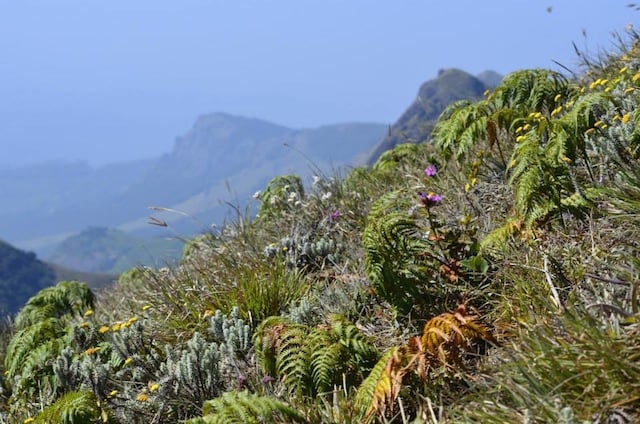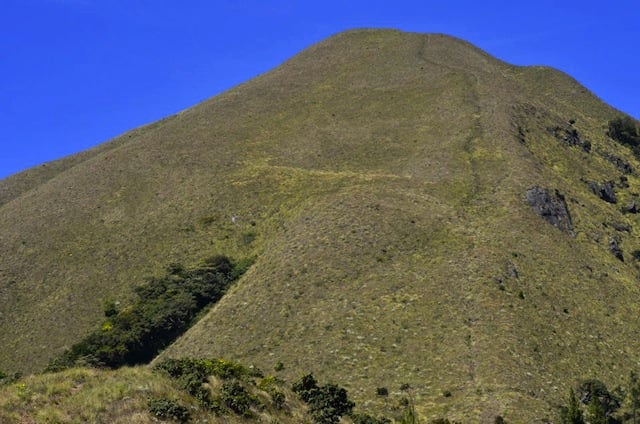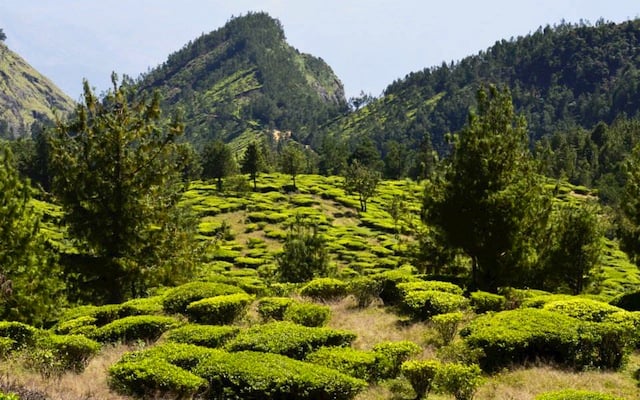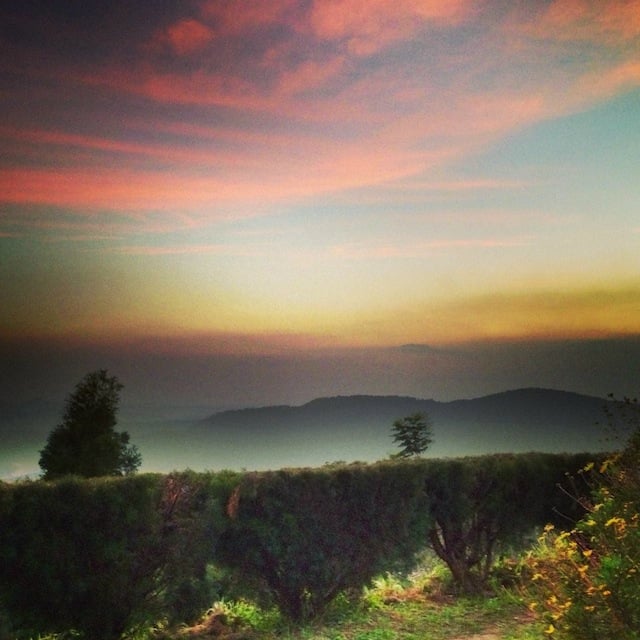
Just one of the many aerial views from atop Meesapulimala
Ascending the second-highest mountain in the Western Ghats. Trekking through the world’s highest organic tea garden.Viewing Nilgiri Tahr, an endemic and endangered species. These are just a few of the many experiences I have on today’s trek.
The group awakes early at our high altitude Rhodo Valley Campsite — situated at 2,200 meters (7,218 feet) in altitude and named for the myriad rhododendrons that litter the area. After an energizing breakfast of fruit, omelet, toast, cookies and couscous, we set out on a 7-kilometer (4-mile) hiking adventure to Anaerangal Camp at Suryanelli, named for the nearby elephant inhabitants.

Colorful hillside hiking up Messapulimala
A Steep Climb
Our first quest is ascending Messapulimala, the second-highest peak in the Western Ghats at 2640 meters (1,640 feet). We trek through mountain grasslands, which are surprisingly level at first, until we reach an abrupt incline. Halfway up, the group stops and glances back at the high-altitude camp from which we just came from, which appears like a speck nestled between high peaks from where I’m standing. Taking a quick photo to commemorate my accomplishment I continue on, until we’re all standing, mouths hanging open and hands grappling for cameras, at the top of the peak.
From here, lush green mountains overlap, creating an illusion of layers and endless peaks. While on one side I see rows upon rows of organic tea, to the other I see Munnar where my journey began yesterday morning. From our aerial point we see the endemic to India and endangered Nilgiri Tahr bounding down mountain rock, looking like a hyper yet graceful mountain lion. Then there’s Korangini, a town that’s the starting point for many treks, and the crystal Anaerangal Lake, or “lake where the elephants come down,” named after the many elephants that use the water for sustenance. While green in various shades is the predominate color of the landscape, flowers in red, white, yellow and purple add contrast to the scene. Who knew hiking in India could be so beautiful?

Only half-way down the extremely steep trail off Meesapulimala
The Rule Of The Mountain
I notice we take an extra long snack break at the top and wonder why. That is, until we face our next adventure: descending the enormous mountain we just climbed up.
Turning to my Kalypso Adventures guide Rattan, my mouth hanging open and eyes bugging out, I gasp. “That’s steep!”
He laughs. “It’s the rule of the mountain. When you go up, you then have to go down.”
For what feels like a mile we trek down steep grassland, slipping on loose pebbles and losing our footing over slippery patches of sand. Despite the struggle, the dramatic scenery of criss-crossing mountains, perfectly-planted tea terraces, vast nothing showcasing the occasional tree, sloping hillside dotted with rhododendrons and tulips, and lazy peaks clouded in mist keeps my attitude positive.
Finally, we’re immersed in shola — or high-altitude rainforest — and find level ground. What had previously been dry yellow grass and bare branches is now thick jungle higher than our heads. What’s interesting to see on the trek is that, although they’re jungles, they’re often found in small patches through the grassland, with hikers having the ability to walk in and out of one within 10 minutes.
Sholas are a very important resource for both India’s ecosystem and people. When it’s dry season, these Amazon-like forests provide water to the rest of the nearby plants. Additionally, the state of Kerala’s 43 lakes originate from sholas, as well as the River Periyar, the longest river in Kerala.

Wandering through the Kolukkumalai Tea Estate, the world’s highest organic tea gardens
The World’s Highest Organic Tea Garden
Once we emerge, we’re in another state, Tamil Nadu, as well as another landscape, this one holding a world title: the world’s highest organic tea garden. Called the Kolukkumalai Tea Estate, it sits at an altitude of 6,500 to 8,000 feet (1,981 to 2,438 meters). According to the Chinese, the world’s best teas are grown at high altitudes, and as China is where tea originated, they’re probably a pretty reputable source.
Actually, next to China, India produces and consumes the most tea in the world. The country has been drinking tea since at least 750 BC, when it was first documented, a heritage facet that still holds strong today.
As we trek through the tea trees — which can actually grow to be 15 feet (five meters) but look like bushes as keeping them shorter allows them to be cut by the tea pickers — I can’t help but wonder how so many different tea varieties can come from the same tree. To my eyes the leaves all look the same, a rich green color with a beautiful sheen; however, Rattan has me take a closer look.

Women working in the high-altitude tea gardens. They wear thick belts around their waist to keep from getting scratched up by the plants.
While the different varieties of tea do indeed grow from the same seed, the age of the leaves and the way they’re processed is what makes the difference between black, green, white and oolong teas. Typically, the young, lighter green leaves provide the best quality. While white is the rarest and most expensive, found in a light green color with sides that fold in, black is the lowest quality, although still has health benefits.
“I tell all my clients to stick with green tea,” says Rattan. “It’s not too expensive and is excellent for your health, especially in the winter when people tend to catch colds.”
And while pretty, the white flowers that grow on the tea leaves actually mean the quality of the tea is not good and those leaves must be disposed of.
At our high elevation the sun is very strong, which is where the pine trees and silver oaks that grow between the tea trees come in. Because tea leaves don’t store water, they need help getting nourishment when it’s dry out. The other trees provide this nourishment, as well as the shade necessary to grow high-quality tea.

Factory worker taking tea leaves out of the drier
A Tea Factory Visit
Because our group wants to learn more about these high altitude organic teas, we head to the factory where the tea is processed (tours are 100 Rupees per person, and the factory is open to the public). Hiking down the steep tea fields and seeing the women pickers — only females can pick tea as their fingers are softer and won’t mar the leaves — amazes me that they’re not falling down. It looks like a grueling job, although I’m reminded by Rattan that these people are deemed very important by the government, who provide them free housing, a nice salary and free education for their children.

Tea bring ground and made smaller before it is dried once again
The first thing I notice once we enter the factory is that it’s extremely hot, as if we’ve entered some kind of fragrant hell. We walk three flights of stairs to the third floor where the process begins with the leaves being dried about one to two hours per day for a week. From there, a variety of machines are used to chop up the leaves and make them finer and smaller. While one machine is mashing and spinning the leaves around rapidly, another is jiggling them and shaking the pieces onto the floor. In another room, a man with an orange head wrap smooths the bits out on the floor in a thick pile. Because any moisture left on the leaves can negatively affect the taste of the tea, the leaves are dried again, leaving small, crispy bits of delicious organic tea.

Despite the bumpy ride, the views of Suryanelli were beautiful
A Bumpy Ride
After the tour, the group jumps into an open-air jeep to reach our accommodation for the night, Anaerangal Camp. Before we leave, Rattan walks over to my side of the vehicle and pulls down a guardrail and ceiling handle. Giggling, he says, “Just a quick warning. This ride might be a little bumpy.”
That’s an understatement, as our driver races like Mario Kart on speed down winding cliffside roads, bouncing over boulders and pot holes and tossing us nearly over steep ledges. As we wind around hairpin turns, he honks to let others know they better get the hell out of his way, because he ain’t slowing down for no one. As my body is thrashed from side to side, I grip my camera tight, trying to capture on film the beauty of what I see down below. From our high perch, the valley nestled in the mountains looks like giant green brains bubbling from the ground, the roads cutting through separating the different cerebral lobes. I forget fear as I soak in this landscape, so different from my own back in New York.

An epic sunset at Anaerangal Camp
About 45 minutes later we make it to Araerangal Camp at 1,600 meters (5,249 feet) and are welcomed with a fresh glass of orange juice. Oranges grow plentifully in southern India, and I welcome the chance to drink in local culture while also reviving myself after a long hike and adventurous 4×4 ride. While the cottage tents are simple, the mountains shrouded in mist appearing like high altitude dunes, and silence — aside for the chirping of birds, crowing of roosters and occasional dog barking — is truly idyllic. It’s the perfect ending to an adventurous day.
Stay tuned for more Bus-Free Through India, with new articles in this 8-part series coming out every Tuesday!
This post is based on a semi-hosted press trip I took with Kalypso Adventures, experiencing their Multi Activity Holiday tour. It’s part of a series called Bus-Free Through India, as the tour focuses on showcasing the real India through cultural, sustainable and adventurous offerings, as well as traveling from place to place by cycling, trekking and kayaking. Stay tuned for this next chapter in my series, Bus-Free Through India.

Jessica Festa is the editor of the travel sites Jessie on a Journey (http://jessieonajourney.com) and Epicure & Culture (http://epicureandculture.com). Along with blogging at We Blog The World, her byline has appeared in publications like Huffington Post, Gadling, Fodor’s, Travel + Escape, Matador, Viator, The Culture-Ist and many others. After getting her BA/MA in Communication from the State University of New York at Albany, she realized she wasn’t really to stop backpacking and made travel her full time job. Some of her most memorable experiences include studying abroad in Sydney, teaching English in Thailand, doing orphanage work in Ghana, hiking her way through South America and traveling solo through Europe. She has a passion for backpacking, adventure, hiking, wine and getting off the beaten path.








